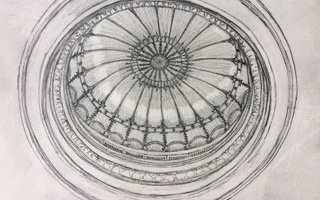When we think of great art, we often think of striking objects and dazzling performances. These pieces, however, never exist on their own—they are framed by the context of the spaces they occupy. “The Room Where It Happens: On the Agency of Interior Spaces,” a symposium held at the Harvard Art Museums as part of Boston’s HubWeek, sought to examine the ways space reflects and even influences both art and the viewer. Featuring 11 speakers, the presentation explored the power of the interior to foment new ideas.
The relationship between human agent and interior was impressively bookended by the symposium’s keynote speakers. The event opened on Friday evening with a lecture by Louis P. Nelson, a professor of architectural history at the University of Virginia. In his talk “Making Room: Cartography, Collecting, and the Construction of Empire,” Nelson argued that the empires of the world were built and validated not only by territorial acquisition, but also by a more abstract conception of authority facilitated by art collection. The deliberate formulation of spaces to house these artifacts served a larger purpose of cementing the idea of empire. Mark Dion, an artist who delivered the closing note of the symposium, makes art which probes the relationship between the observable world we live in and the ideological realms people create. Together, the two invited discussion on how we humans carve out interiors for our own purposes.
The event showcased the versatility of the room. Split into three separate panels: “Rooms for Looking,” “Rooms for Making,” and “Virtual Rooms,” and including locations as diverse as parlors, laboratories, and cockpits, the talk vastly expanded standard ideas of what an indoor space can be. It’s clear that not all spaces are created equal: They are built with specific purposes in mind, giving rise to features which fit the needs of their inhabitants.
Of particular interest was the final panel, which argued that spaces need not be concrete in any conventional sense. One example given by Sarah A. Carter, curator at the Chipstone Foundation, was “Mrs. M.–––––’s Cabinet”, a fictional period room used as an experimental space for students. Centered on an enigmatic, fictional private collector, the room is a constantly-evolving display of objects which challenges us to evaluate how history can be represented. Chad Randl, a lecturer in architecture from Cornell University, took a turn for the whimsical. Looking critically at flight simulators built in homes, he considered the relationship between leisure and the domestic sphere and worked to understand the role of play in belonging to and escaping from the realities of home life. A space need not be tangible or permanent to have an impact on those it interacts with.
For all the interesting insights provided in the presentation, the symposium never neglected the realities of the larger space—the Harvard Art Museums—in which it took place. After each discussion, there was ample time for audience members to pose questions to the panelists. There was also space in between panels to sample the interior of the museum and put its teachings to work. Coupled with a new exhibition, “The Philosophy Chamber: Art and Science in Harvard’s Teaching Cabinet 1766-1820,” the event provided immediate opportunities to apply its lectures to a unique space on campus.
A thought-provoking set of panels, “The Room Where It Happens” was a wonderful addition to HubWeek. The talk asserted that how we create spaces in which to live, observe, and interact tells us a lot about ourselves. Interior spaces can reveal who we as people are on the inside.
Read more in Arts
Music Video Breakdown: ‘Get Into My Car’ by EchosmithRecommended Articles
-
Supposed SecurityI do know that creating safe spaces is important, contrary to a recent New York Times article professing safe spaces as a continuation of the desire of the hyper-sensitive college student to prevent themselves from experiencing “ticklish” conversations and aid in their own “self-infantilization.”
-
The Moose, The Witch, and the WardrobeDunster’s aesthetic beauty and new features, however, belie its fundamentally disappointing use of space. Pool tables and seminar rooms come at the price of in-suite common space for students.
-
Two Undergrads Pioneer Performance Venue in the QuadThe former Penthouse Cafe located on the top floor of the Student Organization Center at Hilles has recently been transformed into a hub of artistic creativity.
-
 Dining Halls
Dining Halls -
Let’s Build TogetherPhysical space is vital, not just because it reflects our commitments, but also because the environment we inhabit and regularly interact with necessarily impacts our experiences in and feelings towards that space.













